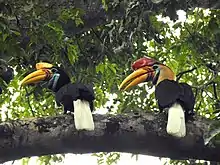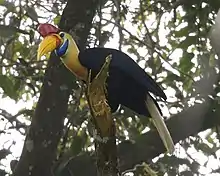Knobbed hornbill
The knobbed hornbill (Rhyticeros cassidix), also known as Sulawesi wrinkled hornbill, is a colourful hornbill native to Indonesia. The species is sometimes placed in the genus Aceros. The knobbed hornbill is the faunal symbol of South Sulawesi province.
| Knobbed hornbill | |
|---|---|
 | |
| A pair (female on left) in the forest canopy Tangkoko Nature Reserve, Sulawesi | |
| Scientific classification | |
| Domain: | Eukaryota |
| Kingdom: | Animalia |
| Phylum: | Chordata |
| Clade: | Dinosauria |
| Class: | Aves |
| Order: | Bucerotiformes |
| Family: | Bucerotidae |
| Genus: | Rhyticeros |
| Species: | R. cassidix |
| Binomial name | |
| Rhyticeros cassidix (Temminck, 1823) | |
| Synonyms | |
| |
Description
This is a large black hornbill with a yellow bill, white tail feathers, pale blue skin around eye, blackish feet and bare dark blue throat. The male has rufous/buff face and neck, orange-red eyes, and a high red casque on the top of his bill. The female has a black face and neck, a yellow casque, and brownish eyes.[3]
Distribution and habitat
An Indonesian endemic, the knobbed hornbill is found in Sulawesi, Buton, Lembeh, Togian and Muna Island. It inhabits evergreen forest at an elevation of up to 1,800 m and also makes use of secondary forest, woodland and plantations for foraging.[1]

Ecology
As with other hornbills, the knobbed hornbill is believed to be monogamous. Its diet consists mainly of fruits, but it will also take insects and small vertebrates. Breeding season spans 27–30 weeks and appears to be triggered by a dramatic reduction in rainfall. The female seals itself inside a tree hole for egg-laying using its own feces. During this time, the male will provide foods for the female and the young through a slit in the seal.[1][3]
Knobbed hornbills are important seed dispersers in their habitat and influence the initial fate of seeds of several tropical forest tree species.[4]
Conservation
The species is currently classified as vulnerable by the IUCN. Despite being locally very common, they are threatened by habitat destruction from logging (since they depend on large and mature trees for breeding) and to some extent by hunting.[1]
Gallery
 Male at Walsrode Bird Park
Male at Walsrode Bird Park Early drawing by the Dutch colonial Natuurkundige Commissie voor Nederlands-Indië, 1820s.
Early drawing by the Dutch colonial Natuurkundige Commissie voor Nederlands-Indië, 1820s..jpg.webp)
 Pair at Walsrode Bird Park, Germany
Pair at Walsrode Bird Park, Germany Skeleton
Skeleton
References
- BirdLife International (2017). "Rhyticeros cassidix". IUCN Red List of Threatened Species. 2017: e.T22682525A117182222. doi:10.2305/IUCN.UK.2017-3.RLTS.T22682525A117182222.en. Retrieved 19 November 2021.
- "Appendices | CITES". cites.org. Retrieved 2022-01-14.
- Josep del Hoyo; Andrew Elliott; David Christie, eds. (2010). Handbook of the Birds of the World. Barcelona: Lynx Edicions.
- Kinnaird, M. F. (1998). "Evidence for effective seed dispersal by the Sulawesi red-knobbed hornbill, Aceros cassidix". Biotropica. 30 (1): 50–55. doi:10.1111/j.1744-7429.1998.tb00368.x. S2CID 84282134.
